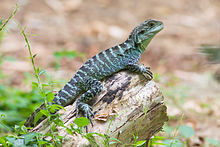Australian water dragon
[4] The species was first described by John Edward Gray in 1831 as Lophura lesueurii, from a specimen collected by Lesueur & Péron at "Parramatta" or "Port Jackson".Its sub-specific epithet commemorates geologist and magistrate Alfred William Howitt, who collected three specimens from the upper reaches of the Buchan River and sent them to McCoy.Both subspecies are light greenish grey in overall colour (greener in I. l. howittii), with darker bands running across their back, tail and legs.The skin will shed during periods of growth and seasonally to reveal brighter colours in Spring that may aid breeding success.Australian water dragons are extremely shy in the wild, but readily adapt to continual human presence in suburban parks and gardens.It can be found near creeks, rivers, lakes, and other water bodies that have basking sites such as overhanging branches or rocks in open or filtered sun.[citation needed] Australian water dragons are prey to carnivorous birds, snakes, cats, dogs, and foxes.Nestlings and smaller juvenile water dragons are vulnerable to predation by kookaburras, currawongs, butcherbirds and other carnivorous birds.An adult diet includes small rodents, such as baby mice, other reptiles, frogs, fish, crabs, yabbies, molluscs, worms and eggs, although insects are still the most commonly consumed.


Conservation statusLeast ConcernIUCN 3.1Scientific classificationEukaryotaAnimaliaChordataReptiliaSquamataIguaniaAgamidaeWellingtonBinomial nameF. McCoySynonymsA.M.C. DumérilBibronFitzingerGirardW. PetersDe VisBoulengersubspeciessemi aquaticagamidspeciesAustraliaVictoriaQueenslandSouth Australiaspecific namenaturalistCharles Alexandre LesueurJohn Edward GrayLesueurPéronAsian water dragonWells and WellingtonFrederick McCoyAlfred William HowittBuchan RiverlectotypenuchaldragonGippslandCanberraclimateshibernatefemalehatchlingsBaskingCity Botanic Gardenscommon nameBrisbane Botanic Gardens, Mount Coot-thaRoma Street ParklandsForest RangekookaburrascurrawongsbutcherbirdsLane Cove National ParkBrisbaneSydneyShoalhaven RiverNew South WalesSydney HarbourRoma Street ParklandBlue Mountains (New South Wales)CooktownPhysignathus cocincinusCochin-ChinaLophuraHydrosaurus amboinensisTallowin, O.Hobson, R.Venz, M.Wilson, S.Shea, G.Vanderduys, E.IUCN Red List of Threatened SpeciesAmey, A.P.Couper, P.J.Beolens BWatkins MGrayson MGray, John EdwardGriffith, EdwardMcCoy, FrederickCoventry, A.J.James Cook UniversityWayback MachineBoulenger GACogger HGWilson SSwan GWikidataWikispeciesiNaturalistObservation.orgOpen Tree of Life